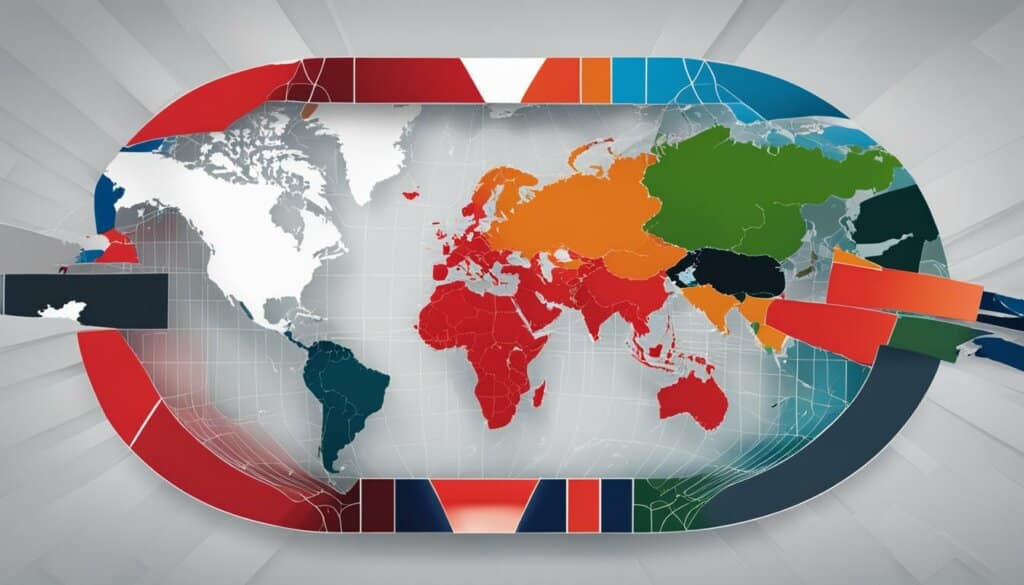Table of Contents
In today’s interconnected world, access to reliable internet has become a necessity. However, there exists a significant gap between those who have access to digital technologies and those who do not. This divide, known as the digital divide, poses challenges to equal opportunities for economic, political, and social participation.
As of 2022, a staggering 2.7 billion people, representing a third of the world’s population, do not have access to the internet. This divide extends globally, with variations in internet penetration across different regions. It is crucial to address this gap and bridge the digital divide to ensure that no one is left behind in the digital age.
The Complexities of Digital Access and Divides
Access to digital technologies is a multifaceted issue that goes beyond geographical boundaries. The digital divide encompasses various gaps based on factors such as gender, age, and urban-rural divide. In 2022, there are 264 million fewer women accessing the internet compared to men, highlighting the gender divide in digital access. Additionally, younger populations tend to have better internet penetration, creating an age-based divide in digital connectivity. These overlapping divides indicate the need for comprehensive solutions that address the complexities of digital access and divides.
It is important to recognize that the digital divide extends beyond mere access to also include digital skills, use of digital technologies, quality of infrastructure, and access to relevant content. Bridging the digital divide requires addressing the multiple dimensions of these divides to ensure equitable opportunities for all individuals. For example, in addition to providing access, there is a need to promote digital literacy and skills development to enable individuals to effectively utilize digital technologies and navigate the online world.
“Access to the full benefits of digital technologies is not just about having a connection; it is about having the necessary skills, knowledge, and empowerment to utilize these technologies to their fullest potential.”
To better understand and address the complexities of digital access and divides, it is essential to adopt a holistic approach. This involves recognizing and addressing the interplay between various factors, such as socio-economic status, education, and infrastructure. By taking into account these overlapping divides and implementing targeted interventions, we can work towards bridging the digital divide and ensuring that everyone has equal opportunities in the digital age.
| Type of Divide | Description |
|---|---|
| Geographic Divide | Differences in access to digital technologies based on location, such as urban-rural divides. |
| Gender Divide | Disparities in digital access and use between men and women. |
| Age Divide | Varying levels of digital access and skills across different age groups. |
| Skills Divide | Gaps in digital literacy and technological skills needed to effectively use digital technologies. |
| Content Divide | Lack of access to relevant and meaningful digital content. |
| Infrastructure Divide | Inadequate or unreliable digital infrastructure, such as internet connectivity and network coverage. |
Understanding the Types of Digital Access
When it comes to bridging the digital divide, it is essential to understand the different types of digital access that individuals may encounter. The United Nations International Telecommunication Union (ITU) categorizes digital access into several key areas that can influence an individual’s ability to fully participate in the digital world. These categories include physical access, financial access, socio-demographic access, cognitive access, institutional access, political access, and cultural access.
Physical access refers to the availability of devices and networks that allow individuals to connect to the internet and digital technologies. It encompasses the availability of hardware, such as computers or smartphones, as well as the presence of reliable internet infrastructure. Financial access, on the other hand, refers to the affordability of internet services and the ability to sustain the necessary resources for being online. It takes into account the cost of devices, data plans, and other related expenses that can act as barriers to access.
| Type of Access | Description |
|---|---|
| Socio-demographic access | Considers factors such as education and income levels that can influence an individual’s ability to access and use digital technologies. |
| Cognitive access | Relates to the level of information and technological literacy needed to effectively use digital technologies. |
| Institutional access | Considers access through schools, community centers, or other institutions that can provide individuals with opportunities to engage with digital technologies. |
| Political access | Examines the impact of political regimes and policies on digital access. It considers factors such as internet censorship, surveillance, and government control. |
| Cultural access | Takes into account the influence of cultural norms, language barriers, and socio-cultural contexts in shaping individuals’ digital access and use. |
These categories highlight the complexity of digital access and the need for a comprehensive approach to bridge the digital divide. By addressing these various types of access, policy-makers, organizations, and communities can work together to ensure that everyone has equal opportunities to benefit from the digital age.
The Impact of the Digital Divide on Developing Countries
The digital divide poses significant challenges for developing countries, especially in the context of the Fourth Industrial Revolution and digital transformation. While advanced economies are accelerating their adoption of digital technologies, many developing countries struggle to keep up, leading to widening economic inequalities. The implications of the digital divide on these countries are far-reaching and require urgent attention.
One of the main consequences of the digital divide is the increased risk of falling behind in the global economy. As developed nations invest more in digital innovation and automation, developing countries that lack access to technology and digital infrastructure face the risk of further marginalization. This can perpetuate existing disparities and hinder economic growth.
Furthermore, the digital divide exacerbates domestic inequalities within developing countries. The cost of technology and the lack of adequate rural-urban infrastructure create barriers to access, exacerbating the digital divide within these regions. This can hinder social mobility and hinder the development of human capital, perpetuating cycles of poverty and inequality.
“Bridging the digital divide is crucial for promoting development, political stability, and resilience in developing countries.”
To address these challenges, a comprehensive approach is needed. Developing countries must prioritize bridging the digital divide through targeted policies and initiatives. This includes investing in the necessary infrastructure, such as broadband networks and reliable electricity supply, to ensure widespread access to digital technologies. Additionally, efforts to enhance digital literacy and skills development are essential to empower individuals and communities to fully participate in the digital economy.
| Key Impacts of the Digital Divide on Developing Countries | Solutions to Bridge the Digital Divide |
|---|---|
| Widening economic inequalities | Investing in digital infrastructure |
| Marginalization in the global economy | Enhancing digital literacy and skills development |
| Domestic inequalities within developing countries | Ensuring affordable access to digital technologies |
| Barriers to social mobility and human capital development | Promoting public-private partnerships |
Efforts to bridge the digital divide in developing countries are crucial for promoting inclusive and sustainable development. By leveraging digital technologies, these countries can enhance their economic competitiveness, improve public service delivery, and foster innovation and entrepreneurship. However, a collective and coordinated approach involving governments, organizations, and technology companies is necessary to effectively address the challenges posed by the digital divide and ensure a more equitable and prosperous future for all.
Addressing the Lack of Research on Digital Divides in Developing Countries
In the realm of bridging the digital divide, it is crucial to prioritize research on developing countries. While much attention has been given to understanding the digital divide in developed nations, there remains a relative lack of research on the broader effects of this divide on structural transformation in developing countries. The unique economic and labor market conditions, as well as the various development trajectories of these countries, necessitate specific research to bridge the gap between policy and successful implementation.
By focusing research efforts on developing countries, we can gain a deeper insight into the challenges they face in achieving digital transformation. This research can help identify contextual factors that contribute to the digital divide and inform targeted strategies to address them. It can also shed light on the impact of the divide on various aspects of development, such as economic growth, social inclusion, and political stability.
To address this research gap, it is important to foster collaboration between academia, governments, and international organizations. Funding bodies should prioritize research projects that focus on understanding and addressing digital divides in developing countries. Research institutions and universities can play a significant role in conducting studies and generating knowledge in this area. Additionally, partnerships between researchers, policymakers, and local communities can ensure that the research findings are translated into effective policies and interventions.
Importance of Digital Divide Research in Developing Countries
“Research on the digital divide in developing countries is crucial for developing evidence-based policies and interventions that can truly bridge the gap. It allows us to understand the unique challenges faced by these countries and tailor solutions accordingly.” – Dr. Sarah Thompson, Research Fellow, Center for Digital Inclusion
By addressing the lack of research on digital divides in developing countries, we can pave the way for more inclusive and equitable digital transformation. It is through research that we can gain a deeper understanding of the barriers faced by these countries and develop targeted strategies to overcome them. With research-informed policies and interventions, we can ensure that the benefits of digital technologies are accessible to all, regardless of their socioeconomic backgrounds or geographic locations.
| Benefits of Research on Digital Divides in Developing Countries |
|---|
| 1. Evidence-based policies: Research provides the foundation for developing policies and interventions that are grounded in empirical data and tailored to the specific needs of developing countries. |
| 2. Informed decision-making: Research allows policymakers to make informed decisions by providing insights into the impact of the digital divide on various aspects of development, such as education, healthcare, and governance. |
| 3. Targeted interventions: Through research, we can identify the factors contributing to the digital divide in developing countries and develop targeted interventions to address them effectively. |
| 4. Collaboration and knowledge-sharing: Research fosters collaboration between researchers, policymakers, and local communities, enabling knowledge-sharing and the co-creation of solutions that are contextually relevant. |
By addressing the lack of research on digital divides in developing countries, we can strive towards a more inclusive and equitable digital future. Through research-driven policies, targeted interventions, and collaboration, we can bridge the divide and ensure that no one is left behind in the digital age.
Navigating the complexity of the digital divide requires a global consensus and stakeholder alignment. Governments, academic institutions, the private sector, and intergovernmental bodies must work together to address this pressing issue. In a world characterized by geopolitical tensions, bridging the digital divide becomes even more challenging. However, it is essential for these stakeholders to set aside their differences and prioritize the public good.
Strong global collaboration is necessary to achieve meaningful progress in bridging the digital divide. By adopting a systems thinking approach, we can better understand the interconnected nature of the divide and develop holistic solutions. Intergovernmental discussions and cooperation can pave the way for effective policy frameworks and initiatives that promote digital inclusion and equitable access to digital technologies.
“Global consensus and stakeholder alignment are essential in addressing the complexities of the digital divide and ensuring that no one is left behind in the digital age.”
Geopolitical tensions can pose significant challenges to bridging the digital divide. However, it is crucial for global stakeholders to maintain an unwavering commitment to the common goal of digital inclusion. By fostering continuous dialogue and collaboration, we can navigate these tensions and work towards a more equitable and inclusive digital future for all.

The Importance of Global Consensus and Stakeholder Alignment
In order to effectively address the digital divide, global consensus and stakeholder alignment are paramount. These efforts require a coordinated and united approach from governments, organizations, and individuals across the world. By aligning their goals and actions, stakeholders can pool resources, share best practices, and work towards common solutions.
Global consensus involves reaching a shared understanding of the challenges posed by the digital divide and agreeing on the steps needed to address them. This consensus-building process requires open and inclusive dialogue, where diverse perspectives are valued and considered. By fostering this collaborative environment, stakeholders can develop a deeper appreciation of the global impact of the digital divide and the urgency in bridging it.
Stakeholder alignment goes beyond consensus to ensure that the actions taken by various actors are coordinated and complementary. This alignment can be achieved through the establishment of collaborative partnerships, information-sharing mechanisms, and joint initiatives. By aligning their efforts, stakeholders can maximize their impact and avoid duplication of resources.
Initiatives and Strategic Plans to Bridge the Digital Divide
Efforts to bridge the digital divide are being undertaken through various initiatives and strategic plans. These initiatives aim to promote digital inclusion and ensure that everyone has access to the opportunities offered by digital technologies. By addressing the barriers to access, improving digital literacy, and fostering equitable distribution of resources, these initiatives seek to reduce the disparities caused by the digital divide.
One example of a digital divide initiative is the World Bank’s Digital Development Partnership. This partnership aims to support countries in developing their digital economies and improving digital infrastructure. It focuses on areas such as expanding broadband access, promoting digital skills training, and fostering innovation and entrepreneurship. Through this initiative, the World Bank aims to promote digital inclusion in developing countries and reduce the digital divide.
Another strategic plan to bridge the digital divide is the United Nations’ Digital Cooperation Roadmap. This roadmap emphasizes the importance of international collaboration and partnerships to address the challenges posed by the digital divide. It calls for investments in digital infrastructure, policies to promote digital rights and trust, and efforts to ensure equal access to digital technologies. The roadmap also emphasizes the need to empower marginalized groups and bridge the gender digital divide.
| Initiative | Description |
|---|---|
| Connectivity for All | This initiative focuses on expanding internet connectivity to underserved areas, particularly in developing countries. It aims to provide affordable and reliable internet access to bridge the digital divide. |
| Digital Literacy Programs | These programs aim to improve digital literacy skills among individuals who lack the necessary knowledge to effectively use digital technologies. They provide training and resources to enhance digital skills and promote digital inclusion. |
| Public-Private Partnerships | Collaborations between governments and private sector entities are crucial in bridging the digital divide. These partnerships can help fund infrastructure development, support digital education initiatives, and ensure equitable access to digital resources. |
“Bridging the digital divide requires a multi-faceted approach that combines infrastructure development, digital education, and equitable access to resources and technologies.” – Digital Inclusion Advocate
These initiatives and strategic plans play a significant role in narrowing the digital divide and promoting digital inclusion. By investing in connectivity, education, and partnerships, governments, organizations, and individuals can work together to ensure that everyone has equal access to digital opportunities. Bridging the digital divide is not just about providing access to technology; it is about empowering individuals and communities to fully participate in the digital world.
The Importance of Digital Literacy in Bridging the Divide
Digital literacy plays a vital role in bridging the digital divide. In today’s digital age, having the necessary digital skills and knowledge is essential for individuals to fully participate in the online world. Digital literacy refers to the ability to effectively use digital technologies, access and utilize software programs, communicate online, conduct online research, and navigate digital spaces safely. It empowers individuals to confidently and competently engage with the digital world, enhancing their opportunities for education, employment, and social connection.
Digital literacy is not just about knowing how to use a computer or a smartphone, but also about understanding the broader implications of technology in our lives. It’s about being critical consumers of information, evaluating the credibility of online sources, and being mindful of privacy and security issues.”
As technology continues to shape various aspects of our lives, from work to leisure, digital literacy becomes increasingly important. It enables individuals to adapt to new technologies, stay informed, and make informed decisions. Digital literacy programs should be implemented not only in public schools but also extended to adults who may lack these skills. Furthermore, private companies should invest in digital training for their employees to promote digital inclusion and reduce the divide.
By prioritizing digital literacy and ensuring that everyone has access to digital education, we can empower individuals and communities to bridge the digital divide. Through comprehensive digital skill-building initiatives, we can equip individuals with the necessary tools to navigate the digital landscape, fostering inclusion, and maximizing the potential of digital technologies for all.

Benefits of Digital Literacy
| Enhanced employability | Improved educational opportunities | Increased access to information |
|---|---|---|
| Individuals with digital skills are more likely to secure employment and thrive in today’s digital job market. | Digital literacy opens up new avenues for learning, enabling individuals to access online educational resources, courses, and certifications. | With digital literacy, individuals can utilize the internet to access a vast amount of information, empowering them to stay informed and continuously learn. |
| Enhanced communication and collaboration | Increased civic engagement | Improved personal efficiency |
| Digital literacy enhances communication skills, enabling individuals to effectively communicate and collaborate with others through various digital platforms and tools. | Being digitally literate allows individuals to participate in online discussions, engage with digital platforms for activism, and have a voice in shaping societal issues. | Individuals with digital skills can leverage technology to streamline tasks, boost productivity, and make daily activities more efficient. |
Digital literacy is a powerful tool for bridging the digital divide. It empowers individuals to navigate the digital world, stay connected, and fully participate in our increasingly technology-driven society.
Ensuring Affordable Internet Access for All
One of the key challenges in bridging the digital divide is ensuring affordable internet access for all individuals, regardless of their socio-economic background. Internet affordability plays a crucial role in enabling equitable access to digital technologies and reducing the disparities in digital inclusion. Without affordable internet service, many individuals face financial barriers that prevent them from accessing the opportunities and resources available online.
To address this issue, partnerships between governments, technology firms, and service providers are essential. By working together, these stakeholders can develop and execute initiatives that aim to make internet access more affordable and accessible. Governments can provide policy frameworks and funding to support the expansion of broadband infrastructure, particularly in underserved areas. Technology companies and service providers can offer affordable data plans and connectivity options tailored to the needs of low-income individuals and communities.
By making internet service more affordable, we can help bridge the digital divide and ensure that everyone has the opportunity to participate in the digital age. This includes access to educational resources, job opportunities, healthcare services, and social connectivity. Affordable internet access is not only a matter of convenience but also a crucial factor in promoting socio-economic development and reducing inequalities. It is a key solution in our efforts to bridge the digital divide and create a more inclusive and equitable digital society.
| Benefits of Affordable Internet Access | Impacts of High Internet Costs |
|---|---|
|
|
Table: Benefits of Affordable Internet Access vs. Impacts of High Internet Costs
Building Stronger Internet Infrastructure for Long-Term Access
Building stronger internet infrastructure is crucial for bridging the digital divide and ensuring long-term access to digital technologies. Robust internet infrastructure forms the foundation for reliable and high-speed broadband access, enabling individuals and communities to fully participate in the digital age. It involves investments in fiber backhaul, middle mile networks, and sustainable architecture to support the increasing reliance on the internet in the future.
By expanding broadband infrastructure, more people will have equitable access to the internet, regardless of their geographic location. This is particularly important in underserved areas where internet connectivity is limited or non-existent. Improved infrastructure not only provides individuals with the ability to connect to the internet but also supports the development of digital ecosystems, enabling businesses to thrive and economies to grow.
| Benefits of Strong Internet Infrastructure | Challenges to Consider |
|---|---|
|
|
To overcome these challenges, governments and organizations need to prioritize internet infrastructure development and consider factors such as renewable energy sources to power the infrastructure, ongoing maintenance plans, and technologies that can withstand natural disasters. Collaboration between stakeholders is essential to ensure that internet infrastructure projects are implemented effectively and efficiently.
By building stronger internet infrastructure, we can bridge the digital divide and create a more inclusive society where everyone has access to the opportunities and benefits that the digital world offers. It is an investment in the future that will empower individuals, drive economic growth, and foster innovation and collaboration.

The Role of Technology Companies in Digital Inclusion
Technology companies play a crucial role in fostering digital inclusion and bridging the digital divide. With their resources, expertise, and innovation, they have the power to enable greater access to digital technologies, improve digital skills, reduce usage risks, and ensure inclusive and ethical innovation. However, it is important to note that not all technology companies are actively contributing to digital inclusion. According to the World Benchmarking Alliance’s findings, only a small percentage of major technology companies are delivering on this front.
For digital inclusion efforts to be effective, technology companies must prioritize key aspects such as human rights, decent work, and ethical practices. By embedding these principles into their operations, they can truly bridge the divide and create a more inclusive digital society. This involves ensuring that their products and services are accessible to all, regardless of income, location, age, or ability. It also requires investing in initiatives that promote digital literacy and skills development, particularly among marginalized communities.
“Technology companies have a responsibility to use their influence and resources for the greater good. It is not enough to simply develop cutting-edge technologies; these innovations must be accessible and beneficial to everyone in society. This means addressing the barriers that prevent individuals from fully participating in the digital world and finding sustainable solutions that leave no one behind.”
Collaboration between technology companies, governments, and civil society is essential in driving digital inclusion forward. By working together, these stakeholders can develop policies, initiatives, and strategies that ensure equitable access, promote digital literacy, and foster a culture of inclusivity within the technology sector. Technology companies should actively engage with local communities, understand their unique needs, and tailor their solutions accordingly. They should also actively seek feedback from diverse voices to ensure that their products and services are accessible and meet the needs of all users.
| Key Actions for Technology Companies | Examples |
|---|---|
| Invest in accessibility and usability | Developing products with built-in accessibility features and user-friendly interfaces |
| Promote digital literacy and skills development | Partnering with educational institutions and non-profit organizations to provide training programs |
| Support affordability initiatives | Offering discounted or subsidized services for individuals from low-income backgrounds |
| Ensure data privacy and protection | Implementing robust security measures to safeguard user information |
| Address digital divides within their workforce | Promoting diversity and inclusion in hiring practices and creating inclusive work environments |
Ultimately, technology companies have the potential to drive positive change and create a more inclusive digital future. By prioritizing digital inclusion, investing in accessibility, promoting digital literacy, and collaborating with stakeholders, they can help bridge the digital divide and ensure that everyone has equal opportunities to participate in the digital world.
Conclusion
In conclusion, bridging the digital divide requires a comprehensive and coordinated effort to address the various aspects of digital inclusion. By focusing on access, skills, affordability, and infrastructure, we can create a society that is more digitally equitable and inclusive.
Initiatives and strategic plans are already underway to bridge the digital divide, with efforts to increase connectivity, provide access to computing devices, and improve digital literacy. However, more needs to be done to ensure that everyone has equal opportunities for digital inclusion.
By investing in digital education, particularly in public schools and for adults who lack digital skills, we can empower individuals to effectively use digital technologies and navigate the online world safely. Additionally, ensuring affordable internet access for all and building stronger internet infrastructure are crucial for long-term access and reducing the barriers to digital inclusion.
Ultimately, bridging the digital divide is a collective responsibility that requires collaboration between governments, organizations, and technology companies. By working together, we can develop sustainable solutions that create a more inclusive and connected future for all.
FAQ
What is the digital divide?
The digital divide refers to the gap between those who have access to reliable internet and those who do not.
How many people do not have access to the internet?
As of 2022, 2.7 billion people, representing a third of the world, do not have access to the internet.
Does the digital divide exist only on a global scale?
No, the digital divide exists on multiple levels, including geographic, gender, age, and rural vs. urban populations.
Are there variations in internet penetration across different regions?
Yes, there are variations in internet penetration across different regions.
What are the different types of digital access?
The different types of digital access include physical, financial, socio-demographic, cognitive, institutional, political, and cultural access.
How does the digital divide affect developing countries?
The digital divide has significant implications for developing countries, particularly in the context of the Fourth Industrial Revolution and digital transformation.
Is there enough research on the effects of digital divides on developing countries?
No, there is a relative lack of research on the broader effects of digital divides on structural transformation in developing countries.
Who needs to work together to address the digital divide?
Governments, academic institutions, the private sector, and intergovernmental bodies need to work together to address the digital divide.
What initiatives are in place to bridge the digital divide?
Initiatives include efforts to increase connectivity, provide access to computing devices, improve digital literacy, and ensure affordable internet service.
How can digital literacy help bridge the digital divide?
Digital literacy plays a vital role in bridging the digital divide by enabling individuals to effectively use digital technologies and navigate digital spaces.
How can internet access be made affordable and equitable?
Internet access can be made affordable and equitable through initiatives that provide affordable internet service and partnerships between governments, tech firms, and service providers.
Why is building stronger internet infrastructure crucial?
Building stronger internet infrastructure is crucial for long-term access and ensuring that communities have reliable access to digital technologies.
What role do technology companies play in digital inclusion?
Technology companies can contribute to reducing the digital divide by enabling greater access to digital technologies, improving digital skills, and ensuring inclusive and ethical innovation.













